Christopher M. Jermaine
ResIST: Layer-Wise Decomposition of ResNets for Distributed Training
Jul 02, 2021



Abstract:We propose {\rm \texttt{ResIST}}, a novel distributed training protocol for Residual Networks (ResNets). {\rm \texttt{ResIST}} randomly decomposes a global ResNet into several shallow sub-ResNets that are trained independently in a distributed manner for several local iterations, before having their updates synchronized and aggregated into the global model. In the next round, new sub-ResNets are randomly generated and the process repeats. By construction, per iteration, {\rm \texttt{ResIST}} communicates only a small portion of network parameters to each machine and never uses the full model during training. Thus, {\rm \texttt{ResIST}} reduces the communication, memory, and time requirements of ResNet training to only a fraction of the requirements of previous methods. In comparison to common protocols like data-parallel training and data-parallel training with local SGD, {\rm \texttt{ResIST}} yields a decrease in wall-clock training time, while being competitive with respect to model performance.
Distributed Learning of Deep Neural Networks using Independent Subnet Training
Oct 04, 2019



Abstract:Stochastic gradient descent (SGD) is the method of choice for distributed machine learning, by virtue of its light complexity per iteration on compute nodes, leading to almost linear speedups in theory. Nevertheless, such speedups are rarely observed in practice, due to high communication overheads during synchronization steps. We alleviate this problem by introducing independent subnet training: a simple, jointly model-parallel and data-parallel, approach to distributed training for fully connected, feed-forward neural networks. During subnet training, neurons are stochastically partitioned without replacement, and each partition is sent only to a single worker. This reduces the overall synchronization overhead, as each worker only receives the weights associated with the subnetwork it has been assigned to. Subnet training also reduces synchronization frequency: since workers train disjoint portions of the network, the training can proceed for long periods of time before synchronization, similar to local SGD approaches. We empirically evaluate our approach on real-world speech recognition and product recommendation applications, where we observe that subnet training i) results into accelerated training times, as compared to state of the art distributed models, and ii) often results into boosting the testing accuracy, as it implicitly combines dropout and batch normalization regularizations during training.
 Add to Chrome
Add to Chrome Add to Firefox
Add to Firefox Add to Edge
Add to Edge